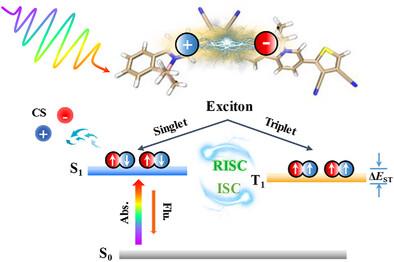双极化结构有机聚合物光催化剂激子动力学调控
IF 19
1区 材料科学
Q1 CHEMISTRY, MULTIDISCIPLINARY
引用次数: 0
摘要
光催化过程中不同反应物质的产生涉及复杂的激子转化机制,目前尚不清楚,这对提高光催化性能提出了关键的学术挑战。本研究以双极化有机聚合物SBN为研究对象,探讨其激子动力学及其对光催化性能的影响。理论计算表明,在SBN中引入B-N Lewis对和氰基显著降低了最低激发自旋单重态(S1)和最低激发自旋三重态(T1)之间的能量分裂,提高了系统间交叉(ISC)和反向系统间交叉(RISC)的效率。光谱分析进一步揭示了SBN中激子在不同温度和时间尺度上的快速可逆ISC和RISC过程。此外,激子的寿命延长,为光催化反应中的电子和能量转移提供了更丰富的时间。这些发现表明,优化的SBN激子动力学为高效光催化提供了强有力的支持。在各种光催化实验中,包括水裂解制氢、硫醚氧化和H2O2合成,SBN表现出明显优于对照聚合物TCC的性能。本文章由计算机程序翻译,如有差异,请以英文原文为准。

Regulating Exciton Dynamics in Organic Polymer Photocatalysts with Dual-Polarization Structure
The generation of different reactive species during photocatalysis involves complex exciton transformation mechanisms that remain unclear, posing a key academic challenge in enhancing photocatalytic performance. This study focuses on a dual-polarized organic polymer, SBN, constructed via molecular engineering strategies, to explore its exciton dynamics and their impact on photocatalytic performance. Theoretical calculations show that the introduction of B–N Lewis pairs and cyano groups in the SBN significantly reduces the energy splitting between the lowest excited spin-singlet (S1) state and the lowest excited spin-triplet (T1) state (∆EST), which enhances the efficiency of intersystem crossing (ISC) and reverse intersystem crossing (RISC). Spectroscopic analysis further reveals the rapid and reversible ISC and RISC processes of excitons in SBN across different temperatures and time scales. Moreover, the lifetime of excitons is extended, providing more abundant time for electron and energy transfer in photocatalytic reactions. These findings demonstrate that the optimized exciton dynamics in SBN provide strong support for efficient photocatalysis. In various photocatalytic experiments, including water splitting for hydrogen production, thioether oxidation, and H2O2 synthesis, SBN exhibits significantly better performance than the control polymer TCC.
求助全文
通过发布文献求助,成功后即可免费获取论文全文。
去求助
来源期刊

Advanced Functional Materials
工程技术-材料科学:综合
CiteScore
29.50
自引率
4.20%
发文量
2086
审稿时长
2.1 months
期刊介绍:
Firmly established as a top-tier materials science journal, Advanced Functional Materials reports breakthrough research in all aspects of materials science, including nanotechnology, chemistry, physics, and biology every week.
Advanced Functional Materials is known for its rapid and fair peer review, quality content, and high impact, making it the first choice of the international materials science community.
 求助内容:
求助内容: 应助结果提醒方式:
应助结果提醒方式:


